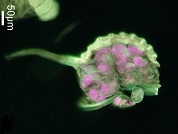Un nuevo helecho híbrido para el Noroeste de Argentina: Pleopeltis × albornozeana (Polypodiaceae)
DOI:
https://doi.org/10.14522/darwiniana.2025.131.1295Palabras clave:
Criptoclorofila, Helechos, Polypodiales, Sudamérica, TaxonomíaResumen
Se describe e ilustra un nuevo híbrido en el género Pleopeltis, cuya distribución abarca las Yungas del Noroeste de los Andes argentinos. Este es el primer híbrido de Pleopeltis registrado para Argentina y para el Cono Sur continental, y el tercero para Sudamérica. El híbrido coexiste con sus dos progenitores putativos, Pleopeltis macrocarpa y Pleopeltis tweediana, y es fácilmente reconocible por sus escamas rizomáticas, de diferentes formas (ovadas, ovado-apiculadas a lanceoladas y largamente caudadas vs. ovado-acuminadas a oblongo-acuminadas en P. tweediana, y lanceoladas a caudadas en P. macrocarpa), además por la disección intermedia de la lámina de las frondes (pinnada en la base y pinnatifida hacia el ápice vs. pinnatifida, a veces con pinnas lobuladas en P. tweediana, y simple en P. macrocarpa), las pinnas irregularmente lobadas y además por sus esporas criptoclorofílicas. Se discuten las relaciones morfológicas y citogenéticas con los parentales putativos y otras especies similares. Pleopeltis × albornozeana es el primer taxón de Pleopeltis de Argentina en el que se reportan esporas criptoclorofílicas. Es de destacar que, en el híbrido, los cromosomas más pequeños tienen las longitudes más cortas reportadas hasta la fecha.
Citas
Abbott, R. J.; M. J. Hegarty, S. J. Hiscock & A. C. Brennan. 2010. Homoploid hybrid speciation in action. Taxon 59: 1375-1386. DOI: https://doi.org/10.1002/tax.595005
Anderson, E. & G. L. Stebbins Jr. 1954. Hybridization as an evolutionary stimulus. Evolution 8: 378-388.
Andújar, C.; P. Arribas, C. Ruiz, J. Serrano & J. Gómez‐Zurita. 2014. Integration of conflict into integrative taxonomy: fitting hybridization in species delimitation of Mesocarabus (Coleoptera: Carabidae). Molecular Ecology 23: 4344-4361. DOI: https://doi.org/10.1111/mec.12793
Arana, M. D.; E. Natale, A. Oggero, N. Ferreti, G. Romano, G. Martínez, P. Posadas & J. J. Morrone. 2021. Esquema biogeográfico de la República Argentina. Opera lilloana 56: 1-240.
Arana, M. D.; A. Slanis & E. Bulacio 2024. Pleopeltis glandulosa (Polypodiales: Polypodiaceae), a new species from the Prepuna district of Monte biogeographic province in Argentina. Phytotaxa 677(2): 181-188. DOI: https://doi.org/10.11646/phytotaxa.677.2.7
Barrington, D. S.; C. H. Haufler & C. R. Werth. 1989. Hybridization, reticulation, and species concept in ferns. American Fern Journal 79(2): 55-64. DOI: http://dx.doi.org/10.2307/1547160
Cerón-Carpio, A. B.; A. F. Rojas-Alvarado, J. D. Tejero-Díez & L. C. Onofre. 2017. Los híbridos de Pleopeltis (Polypodiaceae, Polypodiophyta) en México: novedades y precisiones. Acta Botanica Mexicana 119: 101-114. DOI: http://dx.doi.org/10.21829/ abm119.2017.1234
Cremers, G.; M. Boudrie; R. L. L. Viane & G. Aymonin. 2022. Le Père Charles Plumier (1646 – 1704): son œuvre, son herbier de ptéridophytes américains. – 2. Typifications. Journal de Botanique de la Société Botanique de France 103: 2-117. DOI: http://dx.doi.org/10.3406/jobot.2022.2377
D´Ambroggio de Argüeso, A. 1986. Manual de Técnicas en Histología Vegetal. Buenos Aires: Hemisferio Sur.
Danton, P.; M. Boudrie; A. Bizot & R.L.L. Viane. 2015. Pleopeltis ×cerro-altoensis (Polypodiaceae), A new fern hybrid from Robinson Crusoe Island (Juan Fernandez Archipelago, Chile). The Fern Gazette 20(2): 65-78.
Dassler, C. L. & D. R. Farrar. 2001. Significance of gametophyte form in long-distance colonization by tropical, epiphytic ferns. Brittonia 53: 352-369.
De Souza, F. S. & A. Salino. 2021. Pleopeltis (Polypodiaceae) in Brazil. Phytotaxa 512(4): 213-256. DOI: https://doi.org/10.11646/phytotaxa.512.4.1
Dubuisson, J. Y.; H. Schneider & S. Hennequin. 2009. Epiphytism in ferns: Diversity and history. Comptes Rendus Biologies 332: 120-128.
Ekrt, L. & P. Koutecky. 2016. Between sexual and apomictic: unexpectedly variable sporogenesis and production of viable polyhaploids in the pentaploid fern of the Dryopteris affinis agg. (Dryopteridaceae). Annals of Botany 117(1): 97-106. DOI: https://doi.org/10.1093/aob/mcv152
Evans, A. M. 1963. New Chromosome Observations in the Polypodiaceae and Grammitidaceae. Caryologia 16(3): 661-667. DOI: https://doi.org/10.1080/00087114.1963.10796107
Folk, R. A.; M. L. Gaynor, N. J. Engle‐Wrye, B. C. O'Meara, P. S. Soltis, D. E. Soltis, R. P. Guralnick, et al. 2013. Identifying climatic drivers of hybridization with a new ancestral niche reconstruction method. Systematic Biology 72: 739-752. DOI: http://dx.doi.org/10.1093/sysbio/syad018
Giudice, G. E.; M. A. Morbelli; M. R. Piñeiro; M. Copello & G. Erra. 2004. Spore Morphology of the Polypodiaceae from Northwestern Argentina. American Fern Journal 94(1): 9-27.
Gourbiere, S. & J. Mallet. 2010. Are species real? The shape of the species boundary with exponential failure, reinforcement, and the “missing snowball”. Evolution 64: 1-24. DOI: https://doi.org/10.1111/j.1558-5646.2009.00844.x
Haufler, C. H.; E. A. Hooper & J. P. Therrien. 2000. Models and mechanisms of speciation in pteridophytes: Implications of contrasting patterns in ferns representing temperate and tropical habitats. Plant Species Biology 15: 223-236. DOI: https://doi.org/10.1111/j.1442-1984.2000.00042.x
Haufler, C. H. &. M. D. Windham. 1991. New species of North American Cystopteris and Polypodium, with comments on their reticulate relationships. American Fern Journal 81: 7-23. DOI: https://doi.org/10.2307/1547129
Hietz, P. 2010. Fern adaptations to xeric environments, en K. Mehltreter, L. R. Walker & J. M. Sharpe (eds.), Fern Ecology, pp. 140-176. Cambridge: Cambridge University Press. DOI: https://doi.org/10.1017/CBO9780511844898.006
Hooper, E. A. & C. H. Haufler. 1997. Genetic diversity and breeding system in a group of neotropical epiphytic ferns (Pleopeltis; Polypodiaceae). American Journal of Botany 84(12): 1664-1674. DOI: http://dx.doi.org/10.2307/2446464
Hopper, E. A. 1995. New combinations in the Pleopeltis macrocarpa group (Polypodiaceae: Polypodieae). American Fern Journal 85(3): 75-82. DOI: https://doi.org/10.2307/1547509
Knobloch, I. W. 1996. Pteridophyte hybrids and their derivatives. Michigan: Michigan State University.
Kvaček, Z.; J. Dašková & R. Zetter. 2004. A re-examination of Cenozoic Polypodium in North America. Review of Palaeobotany and Palynology 128(3-4): 219-227. DOI: https://doi.org/10.1016/S0034-6667(03)00134-9
Lagoria, M. A.; G. Avila, D. A. Neira, A. M. Rodríguez, N. F. Ríos, J. Prado & M. A. Hernández. 2018. Morphoanatomical and histochemical characteristics of the epiphytic fern Pleopeltis macrocarpa (Polypodiaceae). Brazilian Journal of Botany 41: 739-750. DOI: https://doi.org/10.1007/s40415-018-0474-8
Lellinger, D. B. 2002. A modern multilingual glossary for taxonomic pteridology. Pteridologia 3: 1-263.
Lewis, W. (1980). Cytogenetics of polyploids, in: W. Lewis (ed), Polyploidy: biological relevance, pp 17-44, New York: Plenum Press.
Liao, R. L.; Y. P. Ma, W. C. Gong, G. Chen, W. B. Sun, R. C. Zhou & T. Marczewski. 2015. Natural hybridization and asymmetric introgression at the distribution margin of two Buddleja species with a large overlap. BMC Plant Biology 15: 146. DOI: https://doi.org/10.1186/s12870-015-0539-9
Mallet, J. 2005. Hybridization as an invasion of the genome. Trends in Ecology and Evolution 20: 229-237. DOI: https://doi.org/10.1016/j.tree.2005.02.010
Mallet, J. 2007. Hybrid speciation. Nature 446: 279-283. DOI: https://doi.org/10.1038/nature05706
Mavarez, J. & M. Linarez. 2008. Homoploid hybrid speciation in animals. Molecular Ecology 17: 4181-4185. https://doi.org/10.1111/j.1365-294x.2008.03898.x
Moran R. C. 2004. A Natural history of ferns. Oregon: Timber Press.
Neira, D. A.; A. R. Andrada, V. A. Páez, A. M. Rodriguez, N. F. Ríos, O. G. Martínez & M. A. Hernández. 2017. Anatomical, histochemical and cytogenetic features of Doryopteris triphylla (Pteridaceae). American Journal of Plant Sciences 8: 907-920. DOI: https://doi.org/10.4236/ajps.2017.84061.
Otto, E. M.; T. Janssen, H. P. Kreier & H. Schneider. 2009. New insights into the phylogeny of Pleopeltis and related neotropical genera (Polypodiaceae, Polypodiopsida). Molecular Phylogenetics and Evolution 53(1): 190-201. DOI: http://dx.doi.org/10.1016/j.ympev.2009.05.001
PPG I (2016). A community-based classification for extant ferns and lycophytes. Journal of Systematics and Evolution 54: 563-603. DOI: https://doi.org/10.1111/jse.12229
Price, T. D. & M. M. Bouvier. 2002. The evolution of F1 postzygotic incompatibilities in birds. Evolution 56: 2083-2089. DOI: https://doi.org/10.1111/j.0014-3820.2002.tb00133.x
Quintanilla, L. G. & A. Escudero. 2006. Spore fitness components do not differ between diploid and allotetraploid species of Dryopteris (Dryopteridaceae). Annals of Botany 98: 609-618. DOI: https://doi.org/10.1093/aob/mcl137
Ranker, T. A. & M. A. Sundue. 2015. Why are there so few species of ferns? Trends in Plant Science 20: 402-403. DOI: https://doi.org/10.1016/j.tplants.2015.05.001
Reeves, A. 2001. MicroMeasure: a new computer program for the collection and analysis of cytogenetic data. Genome 44: 439-443. DOI: http://dx.doi.org/10.1139/gen-44-3-439
Rodriguez, A. M.; M. G. Derita, A. R. Andrada, V. A. Páez, M. Ponce, O. G. Martínez, D. A. Neira & M. A. Hernández. 2024. Glandular trichomes as a source of antifungal metabolites in a karyologically characterized population of Argyrochosma flava: Morphology and histochemistry. Flora 311(30): 152456. DOI: https://doi.org/10.1016/j.flora.2024.152456
Rueda, M. N.; F. C. Salgado‐Roa, Q. C. H. Gantiva, C. Pardo‐Díaz & C. Salazar. 2021. Environmental drivers of diversification and hybridization in neotropical butterflies. Frontiers in Ecology and Evolution 9: 75. DOI: https://doi.org/10.3389/fevo.2021.750703
Sánchez González, L. 2008. Los helechos epífitos; adaptaciones en Polypodiaceae. Universidad Nacional Autónoma de México, México. Recuperado de https://repositorio.unam.mx/contenidos/373093 (accessed February 18, 2025).
Schneider, H.; E. Schuettpelz, K. M. Pryer, R. Cranfill, S. Magallón, & R. Lupia. 2004. Ferns diversified in the shadow of angiosperms. Nature 428: 553-557. DOI: https://doi.org/10.1038/nature02361.
Seehausen, O. 2004. Hybridization and adaptive radiation. Trends in Ecology and Evolution 19: 198-207.
Sharma, A. K. & A. Sharma. 1965. Chromosome techniques, theory and practice. London: Butterworth & Co. (Publishers) LTD.
Schwartsburd, P. B.; L. R. Perrie, P. Brownsey, L. D. Shepherd, H. Shang, D. S. Barrington & M. A. Sundue. 2020. New insights into the evolution of the fern family Dennstaedtiaceae from an expanded molecular phylogeny and morphological analysis. Molecular Phylogenetics and Evolution 150: 106881. DOI: https://doi.org/10.1016/j.ympev.2020.106881
Sigel, E. M. 2016. Genetic and genomic aspects of hybridization in ferns. Journal of Systematics and Evolution 54: 638-655. DOI: https://doi.org/10.1111/jse.12226
Smith, A. R. 1972. Comparison of fern and flowering plant distributions with some evolutionary interpretations for ferns. Biotropica 4: 4-9. DOI: https://doi.org/10.2307/2989639
Smith A. R. & J. T. Mickel. 1977. Chromosome counts for Mexican ferns. Brittonia 29(4): 391-398. DOI: https://doi.org/10.2307/2806481
Smith, A. R. & J. D. Tejero-Díez. 2014. Pleopeltis (Polypodiaceae), a redefinition of the genus and nomenclatural novelties. Botanical Sciences 92(1): 43-58.
Smith, A. R.; M. Kessler; B. León; T. E. Almeida; I. Jiménez-Pérez & M. Lehnert. Prodromus of a fern flora for Bolivia. XL. Polypodiaceae. Phytotaxa 354 (1): 1-67. 2018. DOI: https://doi.org/10.11646/phytotaxa.354.1.1
Sorojsrisom, E. S.; O. Alvarado-Rodríguez & W. Testo. 2023. Goniopteris × tico (Thelypteridaceae), a New Hybrid Fern from Costa Rica. Systematic Botany 48(4): 471-481. DOI: https://doi.org/10.1600/036364423X17000842213632
Sprunt, S.V.; H. Schneider, L. E. Watson, S. J. Russell, A. Navarro Gomez & R. J. Hickey. 2011. Exploring the molecular phylogeny and biogeography of Pleopeltis polypodioides (Polypodiaceae, Polypodiales) Inferred from Plastid DNA Sequences. Systematic Botany 36 (4): 862-869.
Srivastava, R. B. 1985. Ferns of the Indo-Nepal border. Proceedings of the Royal Society of Edinburgh, Section B, 86: 471-472.
Stebbins, G. L. 1940. The significance of polyploidy in plant evolution. American Naturalist 74: 54-66.
Stebbins, G. L. 1950. Variation and evolution in plants. New York: Columbia University Press.
Sundue, M. A.; A. Vasco & R. C. Moran. 2011. Cryptochlorophyllous spores in ferns: Nongreen spores than contain chlorophyll. International Journal of Plant Sciences 172: 1110-1119. DOI: https://doi.org/10.1086/662071
Taylor, W. C.; N. T. Luebke & M. B. Smith. 1985. Speciation and hybridisation in North American quillworts. Proceedings of Royal Society of Edinburgh, Section B, 86: 259-263. DOI: https://doi.org/10.1017/S0269727000008216
Thiers, B. [continuously updated, consulted 2025] Index Herbariorum: a global directory of public herbaria and associated staff. New York Botanical Garden’s Virtual Herbarium. Available at http://sweetgum.nybg.org/ih
Tseng, Y‐H; L‐Y Kuo, I. Borokini & S. Fawcett. 2024. The role of deep hybridization in fern speciation: examples from the Thelypteridaceae. American Journal of Botany 111 (8): e16388. DOI: https://doi.org/10.1002/ajb2.16388
Wagner, W. H. & K. L. Chen. 1965. Abortion of spores and sporangia as a tool in the detection of Dryopteris hybrids. American Fern Journal 55: 9-29. DOI: https://doi.org/10.2307/1546429
Wagner, W. H. Jr. & F. S. Wagner 1975. A hybrid polypody from the New World tropics. The Fern Gazette 11: 125-135.
Wagner, Jr., W. H.; F. S. Wagner & W. C. Taylor. 1986. Detecting abortive spores in Herbarium Specimens of Sterile Hybrids. American Fern Journal 76(3): 129-140. DOI: http://dx.doi.org/10.2307/1547721
Windham, M. D. & G. Yatskievych. 2003. Chromosome studies of cheilanthoid ferns (Peridaceae: Cheilanthoideae) from the western United States and Mexico. American Journal of Botany 90: 1788-1800. DOI: https://doi.org/10.3732/ajb.90.12.1788.
Winkler, M.; M. Koch & P. Hietz. 2011. High gene flow in epiphytic ferns despite habitat loss and fragmentation. Conservation Genetics 12: 1411-1420. DOI: https://doi.org/10.1007/s10592-011-0239-4
Wolf J. H. D. & A. Flamenco-S. 2006. Vascular epiphytes and their potential as a conservation tool in pine-oak forests of Chiapas, Mexico. In M. Kappelle (ed.), Ecology and Conservation of Neotropical Montane Oak Forests, pp. 375-391. Berlin: Springer-Verlag.
Zhang, N. N.; Y. P. Ma, R. A. Folk, J. J. Yu, Y. Z. Pan & X. Gong. 2018. Maintenance of species boundaries in three sympatric Ligularia (Senecioneae, Asteraceae) species. Journal of Integrative Plant Biology 60: 986-999. DOI: https://doi.org/10.1111/jipb.12674

Descargas
Publicado
Cómo citar
Número
Sección
Licencia

A partir de 2012, esta obra está licenciada bajo una Licencia Creative Commons Atribución-NoComercial 2.5 Argentina .
Cualquier obra derivada deberá estar previamente autorizada con nota escrita de los editores.







